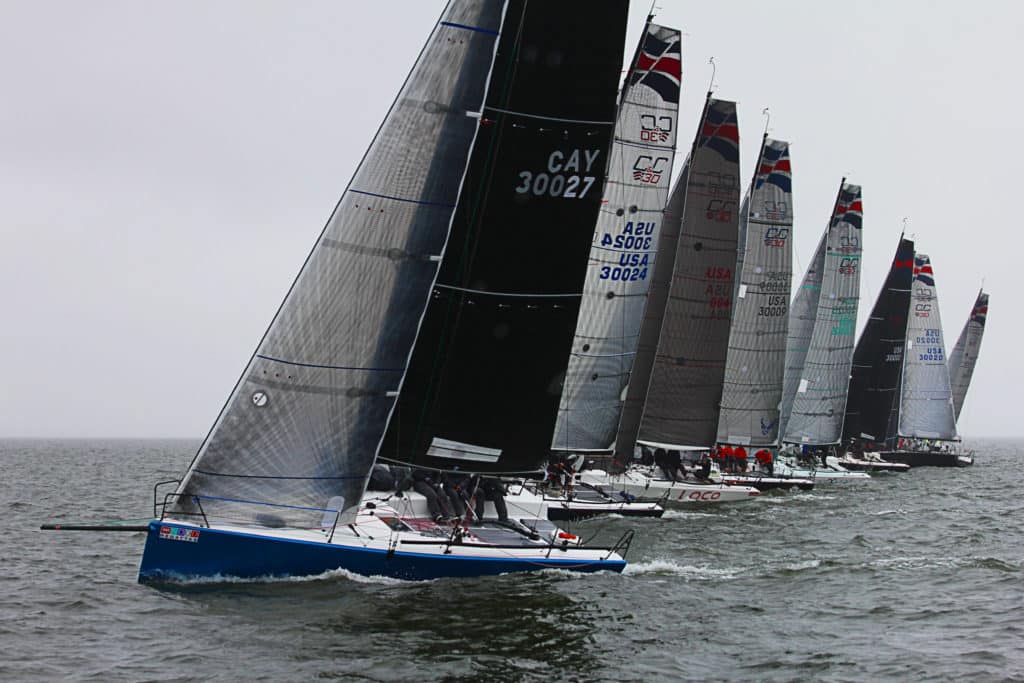
The explosive popularity of keelboat one-designs in the past two decades has been a tremendous boost for sailing. A quick look at the scratch sheets of major U.S. regattas shows several one-design classes populating the majority of entries. Yet what happens when there are not enough entries of a one-design type to form a class for local races? Is it too compromised to race under handicap? It appears so, which is why industry veterans worry that too many boats remain on their trailers or at the dock.
“One-design racing has been great for sailing and great for the industry,” says Vince Brun, of North Sails. “We have been able to develop our sail products and our tuning guides to allow our customers and others to better enjoy the close competition that one-design sailing provides.”
But Brun is one of those worried about a trend he sees: When one-design racing is not available, too many boats remain idle on trailers in his home area of San Diego. “Many of these boats are really fun to sail, and they should be sailed and not just sit waiting for a one-design class to form,” he says.
Seadon Wijsen, the class developer at St. Francis YC’s Rolex Big Boat Series, sees the same effect in the Bay Area but has taken steps to form sportboat classes to bring together like boat types.
“Just like how windward/leeward-only races get pretty boring after a while, we have developed a mix of interesting courses we use here on the bay. People love it for the variety,” says Wijsen. “Racing different but similar designs under fair handicaps can be really fun too. It’s a different game and involves different strategies, but it’s no less enjoyable. Most of the rest of the world races this way. We should have more people trying this here too.”
Wijsen says a key to success is convincing owners that the handicaps are fair and objective, not subject to political wrangling. Andy Rasdal, of San Diego, agrees.
“Over the past 10 years, we have raced a variety of one-design boats, both locally in Southern California and away,” says Rasdal, owner of various Melges one-designs and a Ker-designed Bolt 37, Valkyrie. “In order to affordably sail as much as we’d like, we need to be able to sail in our home area. Yet when we bring in a new higher-performance boat, we are unduly penalized with an unreasonably fast rating because the local rating boards try to protect the fleet. If we were willing to spend years losing, and significant investment, to work the rating down, then we might have a chance. In fact, conversations between competitors after racing here are always about unfair or improper ratings rather than the actual racing or conditions. This is not right.”
Rasdal welcomes the opportunity to sail in Southern California under an objective measured rule. “Although we appreciate the efforts of the volunteers on local rating boards, they just cannot have the expertise, experience or databases to properly rate different boats so that the winners may be determined by the best-prepared and -sailed boats, not which boat and crew has been sailing in the area the longest and has the strongest ties to the rating boards,” he says. Like the sportboats in the Big Boat Series, Brun says, this concept could be even further refined by forming a class of several boat types in the 30-foot range.
“There are lots of older, fast 30-footers, like Mumm 30s and Henderson 30s, that are around, and they could be grouped into a new Fast 30 class, along with more-modern boats, like the C&C 30 and Farr 280, and enjoy good, close racing,” he says. “If we could place all these designs into one class at the big events, it would be a great way to test and establish the concept. I’m confident that after a few owners experience sailing under the new class, we could easily market the idea to other lengths, and get more people motivated to come back out and go racing.”
The idea is actually not new — an ORC Sportboat class was formed at Quantum Key West Race Week in 2016 — but it is now gaining traction among West Coast race organizers, such as the Helly Hansen NOOD Regatta in San Diego, San Diego YC’s Yachting Cup, and North Sails Race Week in Long Beach.
“The ORC tools might be correct for this concept since they are measurement-based, objective, and have been developed successfully for a wide variety of boat types,” says Brun. “This has been done successfully before when there is good measurement data for the boats and the right boat types are placed together in the class. With this approach, we want everyone to feel confident they can get out and race others and have fun, whether in one-design or not. This could help respark interest and variety in local racing — something that benefits everyone.”









